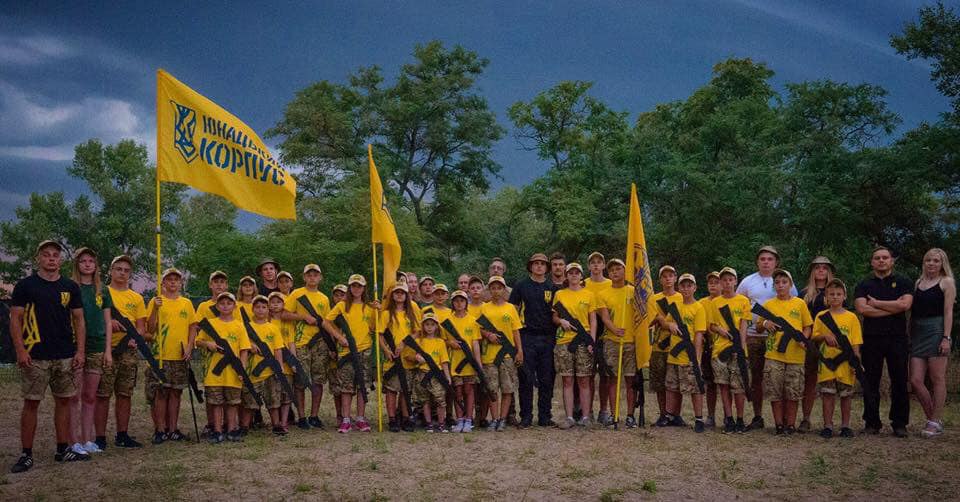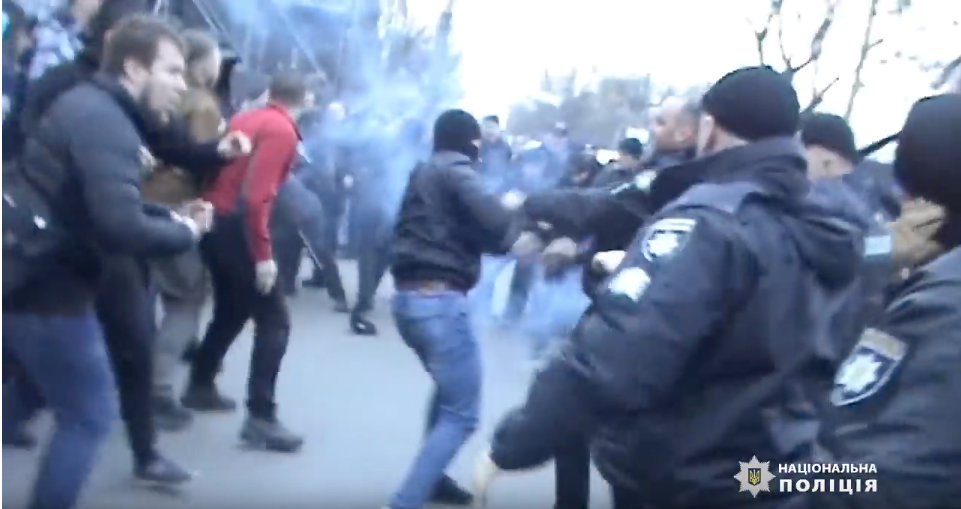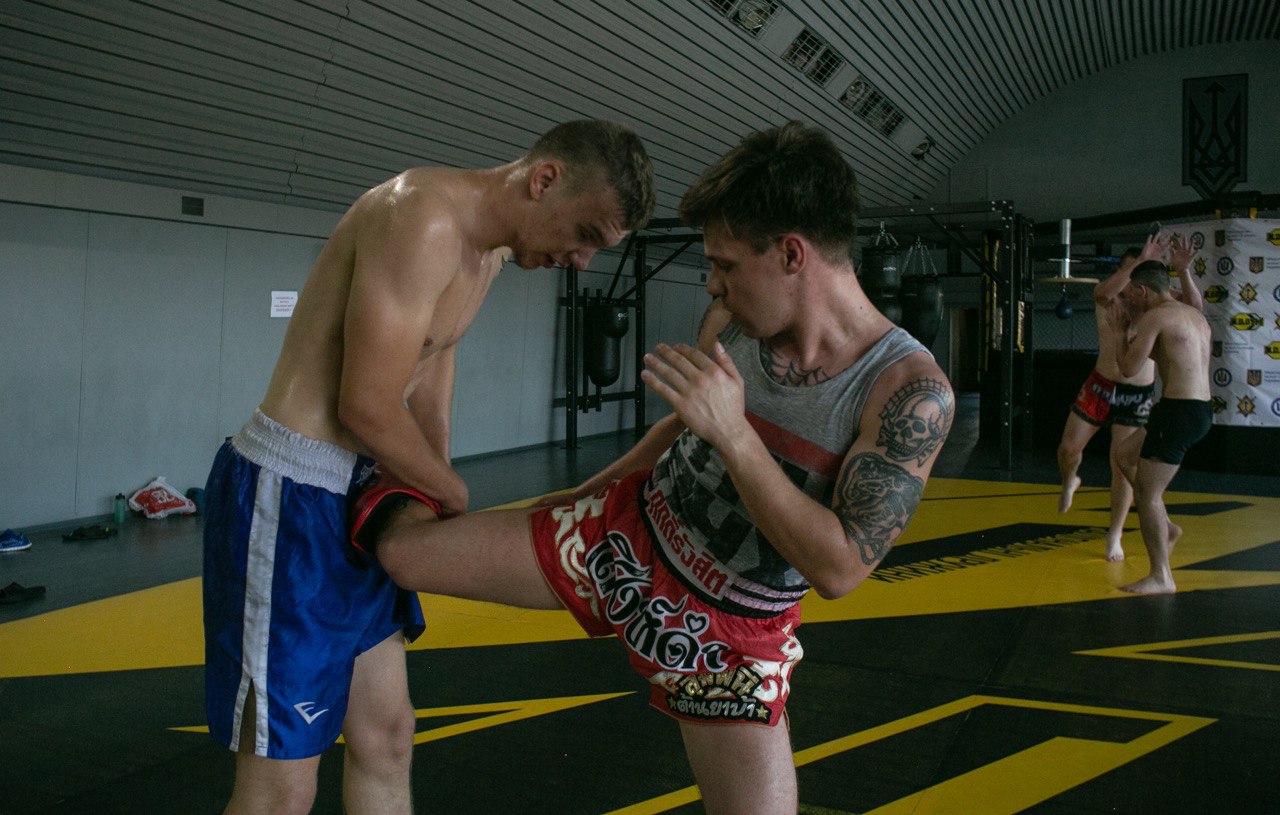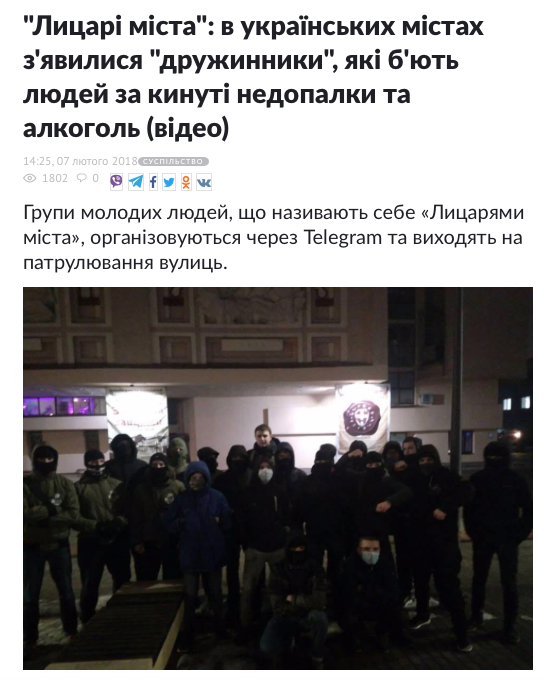Ukrainian Far-Right Extremists Receive State Funds to Teach "Patriotism"
Authored and researched by Oleksiy Kuzmenko, Michael Colborne
Ahead of Ukrainian parliamentary elections on July 21, it is clear from polling data that Ukraine’s far-right groups and their ideas enjoy little popular support among its citizens. Despite this, Ukraine’s government continues to provide funds to notorious far-right extremist groups and their affiliates — including two organizations led by extremists currently on trial for a 2015 murder — to carry out “national-patriotic education” (NPE) programs aimed at young Ukrainians.
An investigation by Bellingcat reveals that far-right organizations run some of the projects funded by state NPE grants, allowing these groups to grow and recruit new members. Moreover, this patriotic youth education was shaped and led by a figure with years of experience in Ukraine’s far-right: Mykola Lyakhovych, Head of the Department for National Patriotic Education in Ukraine’s Ministry of Youth and Sports..
*In response to Bellingcat’s request for commentary the Ministry of Youth and Sports wrote that it would provide requested information “within the time frame designated by Ukraine’s laws”. The law on access to public information allows government bodies up to 20 business days for responses to requests*. Bellingcat also asked the Ministry of Youth and Sports to comment if there are checks in place to ensure that funds for projects cannot be used by an organization for other purposes.
“Nationalist hate group” gets state project funding
For 2019, the government of Ukraine has earmarked eight million hryvnias (over $300,000 USD) for what it calls “national-patriotic education projects” aimed at Ukrainian youth, including children. Of these 845,000 hryvnias — over $30,000 — apparently go to programs that are run by a number of branches of Ukrainian far-right groups, including National Corps, the political wing of the Azov movement. National Corps has been implicated in numerous incidents against minorities, activists and police. This 845,000 hryvnias figure also includes state funding for “national-patriotic education projects” by organizations that are not only arguable fronts for another notorious far-right organization — C14 — but are also led by the accused murderers of Ukrainian reporter Oles Buzyna.

Youth Corps branch of far-right National Corps party holds a summer camp. Children are holding mock AK-47s.
Both National Corps and C14 were explicitly described in a March 2019 US State Department human rights practices report as “nationalist hate groups,” and as “extremist” in a 2018 Freedom House report on far-right extremism in Ukraine.
The Ukrainian government’s decision to fund youth-oriented projects by branches of recognized far-right extremist groups provides these groups with an additional source of legitimacy and, furthermore, adds more fuel to their public efforts to recruit youth into their ranks. For example, a youth-oriented project of National Corps, the Aksyon and Khoma Leadership School, is explicitly described on National Corps’ website as designed to produce “young leaders and commanders” for the far-right organization. In addition, according to the deputy leader of National Corps, Mykola Kravchenko, camps organized for many years by Youth Corps (another branch of National Corps) have provided new members for that far-right movement. Government records show that Youth Corps also received NPE funding in 2018.

In this still from a YouTube video posted by Ukraine’s National Police, members of far-right National Corps clash with law enforcement in Cherkasy in March. Masked person in the center just threw a punch at a policeman. According to Ukraine’s National Police, 22 members of law enforcement were injured in the clashes.
Bellingcat’s findings in this investigation are based on public records, official statements, and reports of the Ministry of Youth and Sports of Ukraine and other branches of the government of Ukraine, as well as social media posts and public statements by leaders and members of the organizations in question.
Government documents detail funding for far-right extremists
Direct affiliates of organizations described as “nationalist hate groups” by the U.S. State Department are among the recipients of state funding for “national-patriotic education projects”, according to a December 2018 decision of a dedicated Ministry of Youth and Sports Commission, and that Ministry’s publication Cooperation-2019 (Співпраця-2019) detailing “national-patriotic education” planned for 2019. Ukraine’s Ministry of Education and Science defines “national-patriotic education” as a comprehensive state policy aimed to “shape high patriotic consciousness” in youth. The concept emphasizes readiness to defend Ukraine’s national interests and the independence of Ukraine – important priorities in the light of Ukraine’s ongoing fight against Russian aggression that has claimed 13,000 lives, and left as many as 30,000 wounded, according to February estimates by the United Nations.
Also listed among goals of NPE by Ukraine’s Ministry of Education and Science is “to encourage a growing personality to actively resist Ukrainophobia, amorality, separatism, chauvinism [and] fascism”. However, the stated goal of the Ukrainian government to teach youth to resist fascism seems at odds with the government’s continued funding of projects from far-right and reportedly neo-Nazi groups to further these very goals.
In several instances analyzed by Bellingcat, organizations that were approved for and apparently received state NPE projects funding share leadership with C14 and National Corps; both of these groups attracted international attention in 2018 because of their reported roles in attacks on members of Ukraine’s Roma minority, LGBT populations, feminist activists, and journalists. Furthermore, in 2019, these same groups made headlines due to violent clashes they had with Ukrainian law enforcement in separate incidents that led to charges against these organizations’ members. For example, in March 2019, clashes between National Corps and police in Cherkasy left 22 members of law enforcement with injuries, according to a statement by Ukraine’s National Police.
Documents analyzed by Bellingcat suggest that Ukraine’s government apparently earmarked 845,000 hryvnias — over $30,000 — for projects by organizations linked to National Corps and C14.
Among those organizations that receive state funding to work with youth are three directly linked to C14: “Union of Veterans of the War with Russia” (Спілка ветеранів війни з Росією) , “National Center for Rights Defense” (Національний центр правозахисту), and “Education Assembly” (Освітня Асамблея). In the case of C14-linked organizations, this new state funding was given in spite of previous reports in international and domestic media that called attention to the practice in 2018.
Also among the recipients of state funds are youth-oriented projects by National Corps-linked Youth Corps, and Aksyon and Khoma Leadership School. The latter received funding through “Civic Corps Azov”, a forerunner to National Corps helmed by Rodion Kudryashov (Родіон Курядшов), a senior figure in National Corps, and Andriy Biletsky (Андрій Білецький), current leader of National Corps.
Handing out diplomas, with state funding and neo-Nazi imagery
While the overall amount of government funding for projects by extremist-linked groups may appear relatively modest (reportedly the average monthly salary in Ukraine was $348 in February), it can be argued that the funding in principle serves as a tacit endorsement of these groups’ actions and ideologies.
Moreover, even the relatively modest amounts of funding earmarked for these groups is sufficient to help them put on more events and to help recruit members into their own ranks — after all, the National Corps-linked Youth Corps and Aksyon and Khoma Leadership School are explicitly training vehicles and a pipeline for future members for Azov’s National Corps.
“Our most important battlefield today is the one where we fight for the soul of the Ukrainian people […] You’ll work with children, and your task is to fight for [their] souls […] They must become of interest to others [kids] once they’re back to their school, street, neighborhood”, leader of National Corps Andriy Biletskiy, a member of Ukraine’s Parliament instructed Youth Corps camp counselors in May 2017. “It is in moments like these that the slogan ‘The future belongs to us!’ is no empty slogan!”, deputy leader of “National Corps” Mykola Kravchenko (Микола Кравченко) wrote in 2018 in a Facebook post where he boasted that some alumni of Youth Corps camps had since gone on to join the National Corps, Azov’s street wing National Militia (Національні Дружини) and the Azov Regiment. According to Kravchenko, “over a thousand boys and girls” attend Youth Corps camps every summer.

Graduates of Aksyon and Khoma Leadership School seminar sponsored by the government of Ukraine with diplomas
Overall, documents reviewed by Bellingcat suggest that organizations linked to National Corps have apparently received approximately 450,000 hyvnias (about $17,000) for children and youth events. These events include a series of trainings dedicated to “shaping of a values compass and solidifying of a national-patriotic mindset in youth and children”, and “a state-wide competition to increase the number of youths ready for duty to defend the sovereignty and territorial integrity of Ukraine”. Far-right, even neo-Nazi elements, were quite literally visible during Aksyon and Khoma Leadership School events that took place in Kyiv recently. Photos from that series of seminars show several attendees with sonnenrad (black sun) tattoos, a common neo-Nazi symbol that the Christchurch shooter had on his backpack during the March 2019 terror attack. Moreover, the head of Aksyon and Khoma Leadership School, Valeriy Gorishniy (Валерій Горішній), sports a visible “Totenkopf” (death’s head) tattoo, another common neo-Nazi symbol.

Valeriy Gorishniy, center, head of the Aksyon and Khoma Leadership School, during part of a state-sponsored seminar. “Totenkopf” tattoo is visible on his left shoulder.
Gorishniy’s social media accounts offer a collection of common neo-Nazi tropes and themes. His username on Facebook is “Valeriy Nachtigall” — a likely reference to the Nachtigall Battalion, a Ukrainian unit of the Nazi armed forces in the early days of the German offensive against the Soviet Union. Gorishniy’s Facebook profile URL (“gorinich88”) features the number “88,” a common neo-Nazi numerical code for “Heil Hitler”; on Instagram, Gorishniy’s handle is “gorinich14”, an apparent reference to the neo-Nazi “14 Words” slogan. In addition, a visible portion of Gorishniy’s private Instagram profile features the phrase “Ruhm und Ehre,” likely a reference to a German neo-Nazi band’s song “Ruhm und Ehre der Waffen SS” (Glory and Honor of the Waffen SS).

Participant of state-sponsored Aksyon and Khoma Leadership School seminar with a sonnenrad (black sun) tattoo on his right elbow.
Aksyon and Khoma Leadership School state-funded seminars featured multiple National Corps ideologues and propagandists, and took place in “Cossack House“, a social center for National Corps that has hosted events with far-right extremists from abroad, including white nationalist Greg Johnson. Participants of these state-funded seminars were also taken to “N.D.Gym” a mixed martial arts and fitness facility operated by the Azov movement.
An accused murderer’s youth camp, on the government’s dime
State funding has also been allocated for two youth-oriented projects from organizations led by suspects in a high-profile 2015 murder of Ukrainian journalist Oles Buzyna: Andriy Medvedko and Denys Polishchuk (they deny the charges). Both are known C14 activists and are free on bail amidst incessant pressure on the court from far-right groups. The “Union of Veterans of the War With Russia” (Спілка ветеранів війни з Росією) led by Medvedko is scheduled to host “Hawk-2019” (Яструб-2019) camp, and “National Center for Rights Defense” (Національний центр правозахисту) co-founded by Medvedko and Polishchuk, and led by the latter, is funded for a project on “national-patriotic Education as the foundation for solidifying civic rights”. In all, state funding for youth-oriented project by C14-linked organizations apparently amounts to 395,000 hryvnias (about $15,000).

Right to left: Andriy Medvedko and Denys Polischuk are charged with murder of Ukrainian reporter Oles Buzyna. Both deny the charges. The investigation and trial are now in their 4th year. Medvedko and Polishchuk lead organizations that receive NPE project funding from the government of Ukraine.
Ukraine’s choice to trust the Medvedko-led organization “Union of Veterans of the War With Russia” to host a camp geared towards youth is additionally worrying because of Medvedko’s recent role in an informal C14-linked violent vigilante group, “Knights of the City” (Лицарі Міста). This group has been reportedly involved with incidents of violence aimed at those it deemed to be addicts or alcoholics, or behave inappropriately on the streets of Kyiv, and other cities in Ukraine.

On the right: A member of far-right C14 during a rally in support of Ukrainians held by Russia. A sonnenrad (black sun) tattoo is visible on his right elbow.
“‘Militias’ in Ukrainian cities beat up people for tossing cigarette butts, and drinking alcohol”, Ukraine’s UNIAN news agency reported on “Knights of the City” in early 2018. In a dedicated Telegram channel, the group detailed beatings — including posting videos of the incidents — of those who chose not to comply with the demands of these self-styled street patrols who have no legal authority in Ukraine. Although the group at times cast itself as avoiding violent confrontations and only responding to aggression, some posts show that members of the group savored violence and acting with impunity. “I’d love to send a message to you morons – we’ll f- all of you up. And our children will hire your uneducated bastard offspring, like unpaid dogs, and they’ll f- them up too for the fun of it. Just like we do with you morons”, one September 2018 Telegram post said.

“”Knights of the City”: “Militias” in Ukrainian cities beat up people for tossing cigarette butts, and drinking alcohol”, Ukraine’s UNIAN news agency reported on Medvedko’s group in early 2018
Even more alarming is that a February 2018 Telegram post stated that members of the group and “officials” visited a specific Ukrainian Roma camp in Kyiv to issue “first and last warning for gypsies [sic] to get the hell out of Kyiv.” The same post described Roma as “human-like creations”.
Just months later, in April 2018, members of C14 attacked Roma camp in the same location, burning it down and chasing inhabitants from their homes. Notably, one early 2018 post in the “Knights of the City” Telegram channel suggested that those “scared of mobs of gypsies” should get in touch with Telegram user @MansonTheWinner. This is apparently the personal Telegram account of Medvedko, who has been known by the nickname “Manson” for almost a decade.
The far-right figure who leads “national-patriotic education” in Ukraine’s government
Giving Ukrainian state funding to projects and programs that may dovetail into recruitment efforts of far-right extremist organizations is not without irony. According to recent polls, few Ukrainians support political parties with explicitly far-right ideologies; with elections on July 21, even a combined “united nationalist bloc” with well-known parties like Svoboda, National Corps, Right Sector, and others has barely been able to reach two percent in polls, far from the five percent needed to get into Ukraine’s parliament. In short — the Ukrainian people are not clamoring for funding to be redirected to these fringe groups, thus making the government’s decision to do so a peculiar one.
This state funding for projects by far-right organizations may stem from a particular figure within one Ukrainian government department: the head of the Department for National-Patriotic Education in Ukraine’s Ministry of Youth and Sports, Mykola Lyakhovych. Lyakhovych himself could even spearhead the very concept of “national-patriotic education”.

Azov Regiment of Ukraine’s National Guard marches in the city of Mariupol in June to mark the liberation of the city from Russia-backed forces in 2014. In Ukraine Azov is credited with playing a decisive role in the liberation. Sonnenrad (black sun) tattoo is visible on the elbow of the flag bearer.
Lyakhovych joined the Ministry in 2015 on the heels of a stint in Ukraine’s notorious Azov battalion (predecessor to both National Corps and Azov Regiment) and a failed bid for Ukraine’s parliament. Prior to this, Lyakhovych led Ukraine’s ultra-nationalist UNA-UNSO [Ukrainian National Assembly – Ukrainian People’s Self-Defence] far-right movement, and had – as detailed on his own site – nearly two decades as a far-right activist and leader under his belt.
Lyakhovych’s personal site also includes a 2014 election endorsement he received from Oleksandr Turchynov, at the time speaker of Ukraine’s parliament; Turchynov went on to lead the National Security and Defense Council of Ukraine from December 2014 until May 2019.
“It’s real patriots like Mykola Lyakhovych who must represent and defend Ukraine in the Rada [Ukraine’s parliament]”, Turchynov said in a video endorsement, adding that he knew Lyakhovych “for many years” and the two had taken part in protests together against Ukraine’s president Kuchma in 2001.
According to Lyakhovych’s site, he spent more than 2 years in prison for his role in anti-Kuchma protests.
Lyakhovych’s links to influential Ukrainian officials and his role in the government is a testament to the tenacity and tactics of Ukraine’s far-right, especially its ability to navigate its members and leaders into positions of influence to shape state policy, whether publicly supported or not. The head of the current Department for National-Patriotic Education’s personal relationship with another influential official in Ukraine, the Minister of Youth and Sports Ihor Zhdanov, might also have played a role in his appointment. In a January 2015 interview, Zhdanov described Lyakhovych as “former fighter of Azov battalion, and my brother from Maidan”. In the same 2015 interview, Zhdanov spoke highly of Lyakhovych’s plans for “national-patriotic education”.

Valeriy Gorishniy, on the right, head of the Aksyon and Khoma Leadership School, hands a diploma of a state-sponsored NPE seminar to a participant. A sonnenrad (black sun) tattoo is visible on right elbow of the recipient.
“He has great ideas,” Zhdanov said in 2015. “First and foremost, national-patriotic education should be propagated throughout schools. We are currently consolidating [support in] ministries and departments, first and foremost in the ministry of education, because it’s through that ministry’s structure that national-patriotic education should be introduced. I believe we’ll change the situation,” he said.
In the years that followed, it was Zhdanov’s protege Lyakhovych who reportedly spurred the creation and implementation of a national strategy on NPE spanning into 2020. Ukraine’s government increasingly invested in NPE. The eight million hryvnias allocated for NPE projects in 2019 is a 100% increase from 2018 NPE funding. Along the way, Lyakhovych has openly echoed the agenda of Ukraine’s far-right. For example, in 2017 he expressed concern that embrace of “hate speech” as a concept by the state could allow “deviants to obtrude their ideas on school kids”. In a public appearance in April 2018, Lyakhovych stated that decisions regarding state funding for NPE projects shouldn’t be influenced by people who don’t represent “Ukrainian values”.
Speaking about the possible composition of a special commission deciding what projects get financial support from the state, Lyakhovych said in 2018: “Obviously we’ll pick, we’ll look at candidates offered to us and check to what extent they carry Ukrainian values, and how much they understand this”.
Fewer than two months later, the very commission Lyakhovych vowed to check for “Ukrainian values” decided to fund projects offered by far-right C14 and its affiliates. The decision came mere months after C14’s violent attacks on Ukrainian Roma. The same pattern has continued into 2019.

Ukrainian policeman injured, according to Ukraine’s National Police, in clashes with far-right National Corps in the city of Cherkasy in March. National Police claims that 22 members of law enforcement were injured in the clashes.
Apparently unswayed by media and human rights organizations’ reports of far-right violence, Ukraine’s government continues to give a boost to the projects, plans and public images of some of the country’s most notorious far-right extremists. It’s clear, as a result, that far-right extremists don’t just benefit from impunity for their actions in Ukraine — their projects benefit from the direct financial help from a state that receives billions of dollars in aid from international donors.



